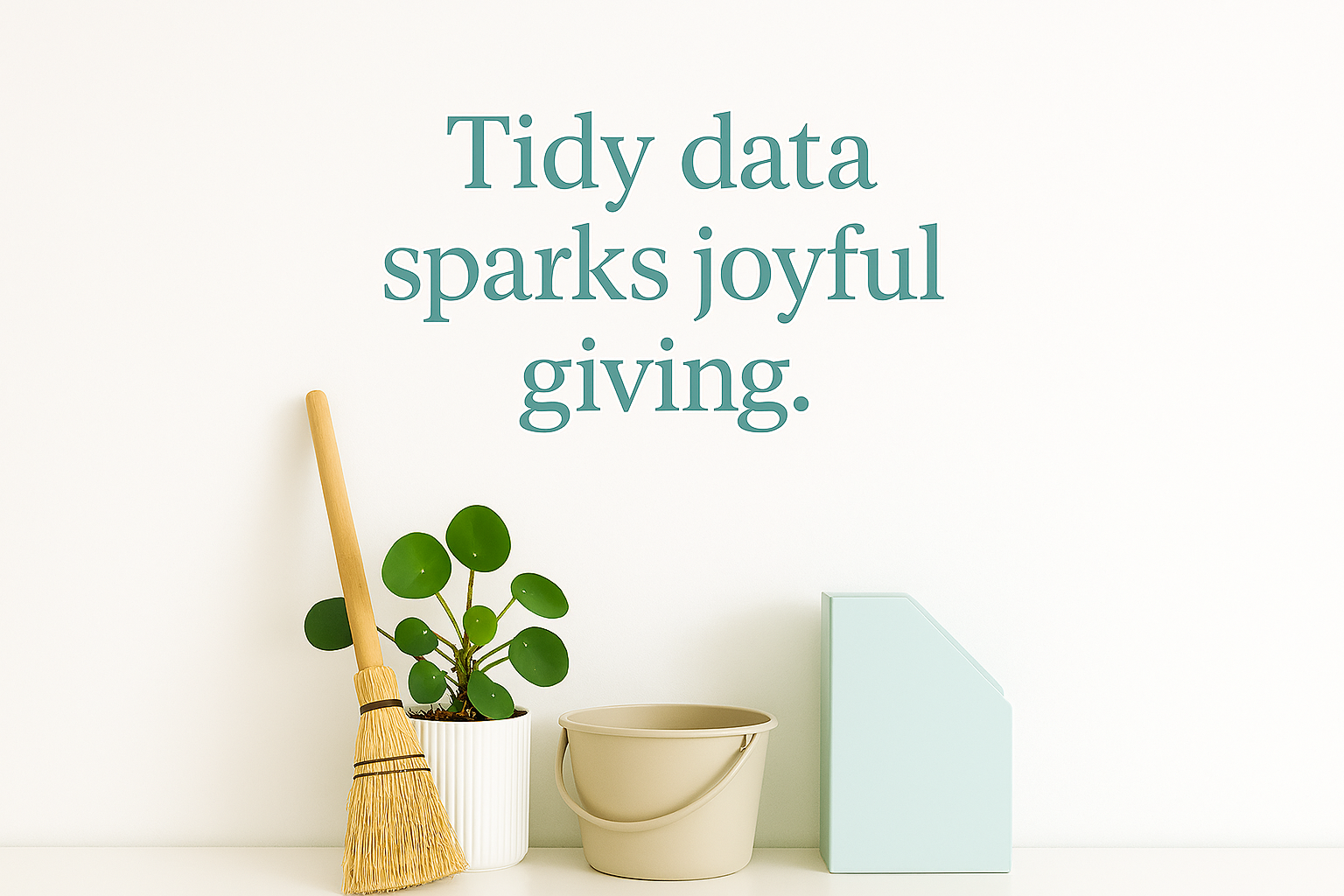by azadi sheridan
It’s summer. The campus is quiet, the calendar a bit kinder, and the inbox (hopefully) not screaming. For advancement professionals in schools and universities, that rare breather can mean only one thing: it’s the perfect time for a CRM spa day.
Welcome to the first of a three-part blog series by Productle, designed to help you Tidy, Sweep, and Polish your constituent data. By the end, you’ll go from “we think they graduated in 2013?” to “we know they preferred red wine at the alumni gala in 2019.”
Tidy, Sweep and Polish sequence
Let’s start with the “Tidy” phase—because before you clean, you need to know what clean even looks like.
Why Clean Data Matters in Advancement
You might think of your CRM as a place to store records. But it's so much more: it's a living system of relationships, histories, preferences, and opportunities. Dirty or outdated data doesn’t just create awkward moments (like emailing “Dear Ms.” to a recent graduate named Jake). It wastes resources, saps productivity, and undermines your outreach.
The Three-Phase Framework
This blog series is structured around three core phases:
Tidy: Set your standards, policies, and expectations.
Sweep: Root out duplicates, gaps, and outdated clutter.
Polish: Enhance and activate your clean data for better outcomes.
Let’s dig into Phase 1.
Tidy: The Mindful Data Declutter
Step 1: Define What “Clean” Means to You
Every school or development office has its own “good enough.” Maybe you’re prepping for an audit. Maybe you're planning the biggest reunion yet. Either way, you need to decide what constitutes “clean data.”
Ask yourself:
What information do we absolutely need for each alum, parent, or donor?
Is “good enough” good enough, or do we need better?
Are we capturing what our constituents expect?
Your definition of quality could range from minimal (“name, email, graduation year”) to gold-standard (“last event attended, giving history, known affiliations”).
🟩 Pro Tip: Make peace with imperfection—some contacts may not need ultra-detailed records. Focus your effort where it counts.
Step 2: Set Standards That Make Sense
It’s hard to clean what you can’t define. That’s why clear data entry guidance is so powerful.
Here’s an example:
Phone Numbers: Always add as type “Mobile.” Mark if it’s unusable.
Consent Rules: Only use phone numbers for fundraising if you have explicit consent.
Address Fields: Three lines max—no more, no less.
Even better, create a data glossary. This helps prevent “what did we mean by ‘notes’ again?” moments and reduces staff guesswork.
Step 3: Map Your Data Landscape
Think beyond individual records. What’s your full ecosystem?
Consider documenting:
A Business Activity Model: What data supports what functions?
A Data Flow Diagram: Where does information come from and go to?
A Business Glossary: Common definitions for terms across teams.
This turns your CRM from a black box into a well-lit library.
Step 4: Get Real About Retention
Here’s the uncomfortable truth: most of us keep data just in case. But there are risks—legal, operational, and reputational—in holding onto information you no longer need (or even know you have).
Start with a Data Retention Policy:
What records do we delete? When?
Are we holding data “forever”? What does that actually mean?
If an alum leaves a legacy, how long should that record remain?
Then build a Retention Schedule:
Pair every item with a review query.
Schedule clean-outs regularly (and back up first!).
Step 5: Actions to Take Right Now
Here’s your end-of-summer tidy checklist:
✅ Define what “good data” means for your team
✅ Create or update your Data Glossary
✅ Draft a Data Entry Guidance document
✅ Build a realistic Retention Policy & Schedule
✅ Set a deletion date for backups
✅ Create a folder so everyone knows where your quality review queries are
Coming Up Next: “Sweep” the Stale Stuff
In Part 2, we’ll dig into the gritty side of data cleaning: finding duplicates, clearing out incomplete records, and breaking up with old addresses (farewell, fax numbers!). We'll also introduce some Excel tricks that make even large-scale sweeps manageable.
🎯 Downloads
Ready to start?
Download our two free desktop wallpapers—a gentle nudge to keep your CRM in shape all year long. Or if you'd like a helping hand, contact us to explore how Productle can support your data health journey.
Desktop wallpaper - Do you need the data?
Desktop wallpaper - Tidy data sparks joyful giving
Clean data isn’t a one-time job—it’s a practice. But with the right mindset, smart tools, and a little summer breathing room, your CRM can become the strategic powerhouse it was always meant to be.
Stay tuned for Part 2: “Sweep: Busting Dupes and Dust in Your CRM”.



